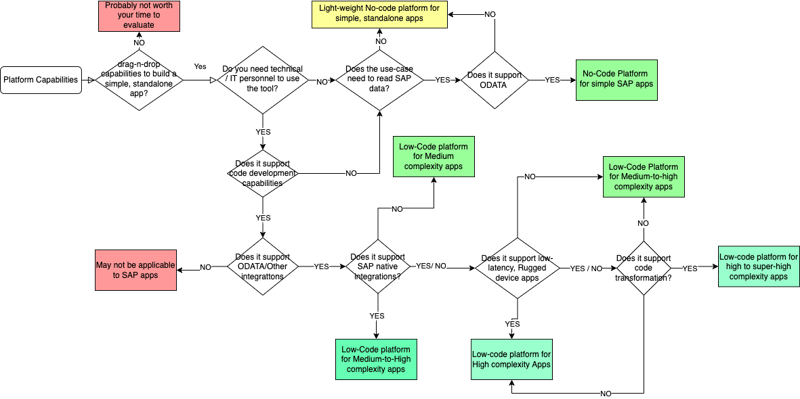The Complete Guide For Low-Code/No-Code Evaluation
Custom application development can be the key to greater efficiency and innovation – but the question of how to create custom code can stand in the way of those goals. Traditional software development processes take time, something that businesses trying to beat the competition to market don’t have. Additionally, in-house IT teams are often focused on upgrades, system consolidation, and other tasks – not necessarily on a line of business (LOB) request. Read on to see our low code evaluation guide.
An effective solution is to deploy a low-code or no-code tool. Platform developers vary in their approach; therefore, different tools provide different capabilities. One way to understand the differences between low-code and no-code platforms is to compare them to interlocking building blocks:
- No-code platforms are like a set of blocks anyone can use to build applications. They provide a WYSIWYG interface for building applications that include a data model and business logic. These platforms enable LOB users without extensive development expertise to use drag-and-drop functionality to create simple applications, such as form apps and surveys.
- Low-code platforms also provide blocks, but they also give developers a kit that they can use to build their own blocks. These platforms enable developers to write and import code, whether proprietary or industry based. They’re designed with developers, functional analysts and the IT department in mind to make creating medium-complexity and high-complexity applications easier and faster.
Another category is transform code, which allows people to transform legacy applications into blocks and provide a kit to build new blocks. These platforms are primarily used to reduce technical debt and enable a clean digital core. Professional developers will find this technology valuable in reducing remediation efforts and enabling legacy application use when transitioning to modern IT environments, for example, from SAP ECC to SAP S/4HANA.
How to Know It’s Time to Consider a Low-Code, No-Code or Transform Tool
Even if you and your team see the value in low-code/no-code technology, transitioning from legacy development processes is a significant change. Additionally, implementing a new platform means another tool to administer and govern. So, how do you know the transition will be a net positive for your organization?
Several factors indicate that your business will benefit from a low-code/no-code tool:
The Talent Shortage
Development talent is difficult to find and retain. Low-code/no-code platforms allow more people with various degrees of development expertise to participate in app building. No-code platforms enable “citizen developers” to create apps even though they have never written a line of code. Furthermore, low-code platforms help seasoned developers work faster, giving them the ability to create reusable objects to save time.
- How many custom app requests are in your backlog?
- Are any there because we don’t have the in-house expertise?
- How long does it take to deliver a custom app?
- How many developers are involved in each project?
- Does our development team have the expertise to create mobile or cloud apps?
- How much time do we spend on building and maintaining APIs?
High Total Cost of Ownership (TCO) of a Bloated SAP Core
Custom objects add to the cost, time, and effort of upgrades, making the transition to a modern IT environment more expensive than a system with a clean core.
Creating a side-by-side configuration with a transform code platform is a more cost-effective strategy, eliminating moving to the new digital core with “baggage” from the old system.
Questions to ask:
- What is in our core tech stack?
- Which core system do we run?
- Is technical debt slowing down service?
- Are the costs of maintaining our system increasing?
A Faster Path to Innovation
Businesses with a large IT backlog have limited agility to meet business demands for new applications. Low-code, no-code, and transform code platforms accelerate speed to delivery without outsourcing. These platforms allow you to focus on innovation, not the task of writing code. Streamlining development processes can help organizations leverage AI, ML, augmented reality (AR), virtual reality (VR) and other advanced capabilities.
Questions to ask:
- Do we use development partners to deliver custom apps?
- Is our current process sustainable?
- Have we delayed transitioning to a new IT environment because of legacy code?

How to Evaluate a No-Code, Low-Code, or Transform Code Platform
Before selecting a low-code/no-code tool, it’s best to assess your in-house resources, their skill sets and their challenges and the types of apps that they need to develop The best platform for simple apps will probably not be the best option for building and deploying composite apps, for example, for SAP and Salesforce, SAP and Workday or SAP and custom systems.
Questions to ask to determine which no-code, low-code, or transform code platform is right for your business:
- Are there business users who want to participate in the software development process?
- Is IT open to collaborating with LOB?
- Are your apps usually integrated with your core system, or are they typically standalone?
- Do app development projects usually have several iterations?
- Which traditional programming languages does your team use today?
- Do your apps need to run offline?
- Which form factors do you use to run apps (e.g., web, mobile, tablet, rugged, RF scanner, etc.?)
- Does the platform need to be fully native to your cloud provider?
Other considerations include whether you need to build standalone or integrated apps and whether your team needs workflow capabilities in the platform. It’s also advisable to consider your needs today and what you may need in the future, for example, minimizing technical debt before transitioning to a new IT environment.
The no-code/low-code platform you choose should feature:
- WYSIWYG, drag-and-drop development canvas
- Support for native mobile components in addition to web components
- Visual tool for application logic
- Visual tool to integrate SAP or third-party systems
- Visual workflow engine to define workflows across applications with state management and state transitions
- Leverages roles and authorizations from SAP
- Leverages your identity authentication solution
- Mobile security
- Platform security
- Ease of deployment
- Version management
- Landscape architecture that aligns with SAP landscape
- Support for various mobile deployment models
- Support for offline mobile apps
- Support for use with rugged or industrial devices
- Platform extensibility
- Platform hosting
- Cloud-native, if hosted in the cloud
- Reliability and redundancy; SLA that meets your needs for uptime
- Prebuilt applications, templates, connectors and other content
In addition to evaluating low-code/no-code platform options, businesses should vet the platform vendor. Learn more about its partner ecosystem and whether it has an active community, how it delivers support and training, and its pricing model. Implementing a low-code/no-code platform requires an ongoing relationship with the vendor. Ensure that partnership will be beneficial to your company.
Go Into Low-Code/No-Code Development with Your Eyes Wide Open
When you decide to move forward with low-code/no-code platform implementation to enhance software development, the best strategy is to manage change and get buy-in from your team. You may encounter “developer syndrome,” which manifests as pushback from developers who may see the platform as a threat to their employment. Additionally, depending on the platform, their core responsibilities may change, for example, from writing ABAP, creating OData connectors, or working in JavaScript or NetWeaver to front-end and back-end app development, data modeling, and integration.
On the other hand, you may be excited by the prospect of having “citizen developers” create apps without formal development training, but they may not see time in their schedules to do so.
You also need to combat the urge for people to fall back to old, familiar processes. Educate your team about the benefits of low-code/no-code development, such as the time savings for your team, the ability to hire people with more diverse skillsets, and a more productive development team.
Also, remember that more than one no-code/low-code tool may be necessary to meet your needs, which means more tools to administer and govern.
Where to Begin your low-code/no-code evaluation
The best plan is to start slowly, focusing on small success with LOBs. Choose one or two medium-complexity use cases, work closely with the vendor for timely delivery, and focus on user adoption of those apps. Additionally, identify one or two developers who will champion the solution and communicate its value to their colleagues.
Once your business experiences success with the process and the apps it delivers, scale to develop more apps and put governance policies in place. Within 24-36 months, you’ll see benefits across your organization – and developers and business users will consider the platform a standard part of their workflows.
Download our Low Code Evaluation Guide
We've created a downloadable evaluation guide, which will help you rate the solutions you are considering. Download it now!




 Back
Back/Logo%20-%20black%20text%20blue%20pillar%20(large)-1.jpg)

